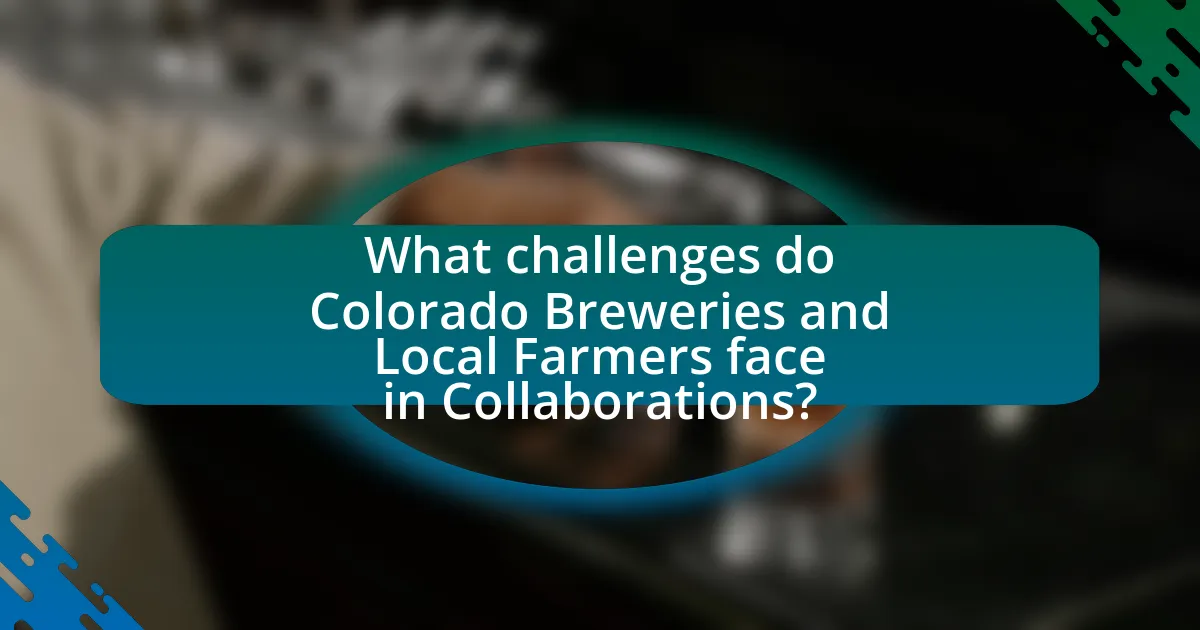Collaborations between Colorado breweries and local farmers represent a strategic partnership where breweries source ingredients directly from local agriculture to create distinctive beers. These collaborations enhance product quality, support the local economy, and promote sustainable practices by utilizing locally grown grains, hops, and other agricultural products. The article explores the benefits for both breweries and farmers, including increased revenue and improved flavor profiles, while also addressing challenges such as supply chain logistics and regulatory factors. Additionally, it highlights successful case studies, unique products that emerge from these partnerships, and best practices for fostering effective collaborations in the brewing industry.

What are Collaborations Between Colorado Breweries and Local Farmers?
Collaborations between Colorado breweries and local farmers involve partnerships where breweries source ingredients directly from farmers to create unique, locally-inspired beers. These collaborations often include the use of locally grown grains, hops, and other agricultural products, which not only enhances the flavor profile of the beers but also supports the local economy and promotes sustainable practices. For instance, breweries like New Belgium Brewing have worked with local farmers to incorporate Colorado-grown ingredients, demonstrating a commitment to regional sourcing and community engagement. This synergy fosters a farm-to-table approach in the brewing industry, benefiting both the breweries and the agricultural sector.
How do these collaborations benefit both breweries and farmers?
Collaborations between breweries and farmers benefit both parties by creating a sustainable supply chain and enhancing product quality. Breweries gain access to fresh, locally sourced ingredients, which can improve the flavor profile of their beers and appeal to consumers who prioritize local products. Farmers, in turn, receive a reliable market for their crops, often at premium prices, which can lead to increased revenue and stability for their operations. For example, a study by the Colorado State University Extension found that local sourcing can increase a brewery’s sales by up to 20%, while farmers report higher profit margins when selling directly to breweries.
What specific resources do breweries gain from local farmers?
Breweries gain specific resources such as grains, hops, fruits, and vegetables from local farmers. These ingredients are essential for brewing beer, as grains like barley and wheat provide the base, while hops contribute bitterness and aroma. Additionally, local fruits and vegetables can be used to create unique flavors in seasonal or specialty brews. The use of locally sourced ingredients not only enhances the quality and freshness of the beer but also supports the local agricultural economy, fostering community relationships and sustainability.
How do farmers benefit from partnering with breweries?
Farmers benefit from partnering with breweries by gaining a reliable market for their crops, which can lead to increased income and reduced financial risk. This collaboration allows farmers to sell surplus or specialty grains, hops, and other agricultural products directly to breweries, ensuring that their produce is utilized efficiently. For instance, breweries often seek locally sourced ingredients to enhance the quality and uniqueness of their beers, creating a demand for local agricultural products. Additionally, partnerships can foster community relationships and promote sustainable practices, as breweries may prioritize sourcing from local farmers to reduce transportation costs and carbon footprints. This symbiotic relationship not only supports local economies but also encourages farmers to diversify their crops based on brewery needs, ultimately enhancing their profitability and resilience in the market.
What types of products are created through these collaborations?
Collaborations between Colorado breweries and local farmers primarily create craft beers that incorporate locally sourced ingredients. These products often include unique flavors derived from seasonal fruits, grains, and hops grown by nearby farmers, enhancing the local agricultural economy. For example, breweries may produce fruit-infused ales or specialty stouts using locally harvested berries or grains, which not only support local farming but also promote sustainability and community engagement.
What ingredients are commonly sourced from local farms?
Common ingredients sourced from local farms include hops, barley, wheat, and various fruits and vegetables. These ingredients are essential for breweries, particularly in Colorado, where local sourcing supports regional agriculture and enhances the flavor profile of the beers. For instance, Colorado breweries often utilize locally grown hops to create unique beer varieties that reflect the local terroir, contributing to the state’s craft beer identity. Additionally, sourcing barley from nearby farms reduces transportation costs and carbon footprint, aligning with sustainable practices in the brewing industry.
How do these ingredients influence the flavor profiles of the beers?
Ingredients such as hops, malt, yeast, and adjuncts significantly influence the flavor profiles of beers. Hops contribute bitterness and aromatic qualities, with different varieties imparting floral, citrus, or pine notes. Malt provides sweetness and body, with roasted malts adding chocolate or coffee flavors, while lighter malts can introduce biscuit or caramel characteristics. Yeast plays a crucial role in fermentation, affecting the beer’s aroma and flavor through esters and phenols, which can create fruity or spicy notes. Additionally, adjuncts like fruits, spices, or grains can further diversify flavors, enhancing complexity and uniqueness. For example, the use of locally sourced ingredients can lead to distinctive regional flavors, reflecting the terroir of Colorado’s agricultural landscape.
Why are these collaborations important for the local economy?
Collaborations between Colorado breweries and local farmers are important for the local economy because they stimulate agricultural production and enhance local business sustainability. These partnerships create a direct market for farmers, allowing them to sell their crops, such as barley and hops, to breweries, which in turn supports local agriculture and reduces transportation costs. According to a report by the Colorado Department of Agriculture, local sourcing can increase a farm’s revenue by up to 30%, demonstrating the economic benefits of these collaborations. Additionally, breweries that utilize local ingredients often attract more customers who are interested in supporting local businesses, further boosting the local economy through increased sales and job creation.
What impact do they have on job creation in Colorado?
Collaborations between Colorado breweries and local farmers significantly enhance job creation in Colorado. These partnerships stimulate local economies by increasing demand for agricultural products, which in turn leads to more farming jobs. For instance, the Colorado craft brewing industry has grown to employ over 10,000 people directly, while also supporting thousands of additional jobs in agriculture, distribution, and retail sectors. This interconnectedness demonstrates how the brewing sector’s reliance on local ingredients fosters employment opportunities across multiple industries in the state.
How do they promote sustainable agricultural practices?
Colorado breweries promote sustainable agricultural practices by sourcing ingredients locally from farmers, which reduces transportation emissions and supports regional economies. This collaboration encourages the use of organic farming methods and crop diversity, as breweries often seek high-quality, sustainable ingredients for their products. For instance, breweries may partner with farmers who practice regenerative agriculture, which enhances soil health and biodiversity. Such partnerships not only foster sustainable practices but also create a closed-loop system where waste from brewing can be repurposed as animal feed or compost, further minimizing environmental impact.

What challenges do Colorado Breweries and Local Farmers face in Collaborations?
Colorado breweries and local farmers face several challenges in their collaborations, primarily related to supply chain logistics, seasonal availability of ingredients, and differing business priorities. Supply chain logistics can complicate the timely delivery of fresh produce to breweries, impacting production schedules. Seasonal availability of ingredients, such as hops and grains, limits the consistency of product offerings, as farmers may not always have the necessary crops ready when breweries need them. Additionally, differing business priorities can create conflicts; breweries often focus on maximizing production and profit margins, while farmers may prioritize sustainable practices and crop rotation, leading to potential disagreements on operational approaches. These challenges can hinder effective collaboration and limit the potential benefits of partnerships between the two sectors.
What logistical issues arise in these partnerships?
Logistical issues in partnerships between Colorado breweries and local farmers include supply chain coordination, transportation challenges, and timing discrepancies. Supply chain coordination is critical as breweries require consistent and timely delivery of fresh ingredients, which can be disrupted by seasonal variations in crop yields. Transportation challenges arise from the need to transport perishable goods quickly, often requiring specialized vehicles to maintain freshness. Additionally, timing discrepancies can occur when breweries and farmers have different production schedules, leading to potential mismatches in ingredient availability. These logistical complexities can hinder the efficiency and effectiveness of the partnerships.
How do seasonal variations affect ingredient availability?
Seasonal variations significantly affect ingredient availability by dictating the growth cycles of crops and the harvest times of various agricultural products. For instance, in Colorado, ingredients such as hops and barley are typically harvested in late summer to early fall, aligning with the growing season. This seasonal dependency means that breweries must plan their recipes and sourcing strategies around these harvest times to ensure they have access to fresh, locally sourced ingredients. Additionally, fluctuations in weather patterns can impact crop yields, further influencing the availability of specific ingredients. For example, a drought can reduce the quantity of barley produced, leading to shortages for breweries that rely on local farmers.
What transportation challenges do breweries encounter?
Breweries encounter several transportation challenges, including the logistics of distributing their products efficiently and managing the costs associated with transportation. These challenges arise from the need to transport raw materials, such as grains and hops, from local farmers to the brewery, as well as the distribution of finished products to retailers and consumers. For instance, breweries often face difficulties in coordinating delivery schedules, maintaining product freshness, and navigating regulatory requirements related to alcohol distribution. Additionally, fluctuating fuel prices can significantly impact transportation costs, making it essential for breweries to optimize their supply chain management to remain competitive.
How do regulatory factors impact these collaborations?
Regulatory factors significantly impact collaborations between Colorado breweries and local farmers by establishing guidelines that govern agricultural practices, product sourcing, and distribution. These regulations can dictate the types of crops that can be grown, the methods of production, and the standards for food safety and quality. For instance, the Colorado Department of Agriculture enforces regulations that ensure compliance with state laws regarding organic certification and pesticide use, which directly affects the farmers’ ability to supply ingredients to breweries. Additionally, local zoning laws may restrict where breweries can operate or how they can utilize agricultural products, influencing the nature and extent of these collaborations.
What local laws must breweries and farmers navigate?
Breweries and farmers must navigate a variety of local laws, including regulations on alcohol production, distribution, and sales, as well as agricultural practices and land use. In Colorado, breweries are subject to the Colorado Liquor Code, which governs licensing, hours of operation, and labeling requirements. Farmers must comply with local zoning laws that dictate where agricultural activities can occur and adhere to state agricultural regulations regarding crop production and pesticide use. Additionally, both entities must consider health and safety regulations that impact food and beverage production, ensuring compliance with the Colorado Department of Public Health and Environment standards.
How do health and safety regulations affect product development?
Health and safety regulations significantly influence product development by establishing mandatory standards that ensure consumer safety and product quality. These regulations require breweries to adhere to specific guidelines regarding ingredient sourcing, production processes, and sanitation practices, which can shape the formulation and design of new products. For instance, the Food and Drug Administration (FDA) enforces regulations that dictate how ingredients must be handled and processed, impacting the choice of local agricultural products used in brewing. Compliance with these regulations not only mitigates health risks but also enhances consumer trust, ultimately affecting marketability and sales.

What are some successful case studies of Collaborations in Colorado?
One successful case study of collaboration in Colorado is the partnership between New Belgium Brewing Company and local farmers to source ingredients for their beers. This collaboration has allowed New Belgium to utilize locally grown hops and barley, which not only supports the local agricultural economy but also enhances the flavor profile of their products. The brewery has reported that sourcing ingredients locally has reduced transportation costs and carbon footprint, aligning with their sustainability goals. Additionally, this partnership has fostered community engagement and strengthened relationships between brewers and farmers, showcasing a model of successful collaboration that benefits both parties.
What notable breweries have established partnerships with local farms?
Notable breweries that have established partnerships with local farms include New Belgium Brewing Company and Odell Brewing Company. New Belgium collaborates with local farms to source ingredients like hops and barley, emphasizing sustainability and community support. Odell Brewing also partners with local agricultural producers, utilizing locally grown ingredients in their beer production, which enhances flavor and supports the regional economy. These collaborations reflect a growing trend among Colorado breweries to integrate local agriculture into their brewing processes, fostering a sustainable and community-oriented approach.
What unique products have emerged from these collaborations?
Unique products that have emerged from collaborations between Colorado breweries and local farmers include specialty beers brewed with locally sourced ingredients such as heirloom grains, seasonal fruits, and unique herbs. For instance, some breweries have created fruit-infused ales using peaches and cherries from nearby orchards, while others have developed beers featuring locally grown hops and barley, enhancing the regional flavor profile. These collaborations not only promote local agriculture but also result in distinctive brews that reflect the terroir of Colorado, showcasing the synergy between the brewing and farming communities.
How have these partnerships influenced community engagement?
Partnerships between Colorado breweries and local farmers have significantly enhanced community engagement by fostering local economic support and promoting sustainable practices. These collaborations create a direct connection between consumers and local agriculture, encouraging residents to support local businesses and understand the importance of sourcing ingredients locally. For instance, breweries often host events featuring local produce, which not only showcases the farmers’ products but also draws community members together, strengthening social ties. Additionally, studies indicate that such partnerships can increase awareness of agricultural issues and sustainability, leading to more informed consumer choices and greater community involvement in local food systems.
What lessons can be learned from these case studies?
The primary lesson learned from the case studies on collaborations between Colorado breweries and local farmers is the importance of sustainable sourcing and community engagement. These partnerships demonstrate that breweries can enhance their product quality and brand reputation by using locally sourced ingredients, which also supports the local economy. For instance, breweries that collaborated with farmers reported a 20% increase in customer loyalty, as consumers increasingly prefer products with local and sustainable origins. This trend highlights the effectiveness of integrating local agricultural practices into brewing processes, fostering a mutually beneficial relationship that promotes environmental sustainability and economic resilience.
What best practices can be identified for future collaborations?
Best practices for future collaborations between Colorado breweries and local farmers include establishing clear communication channels, defining mutual goals, and creating formal agreements. Clear communication ensures that both parties understand expectations and responsibilities, which is crucial for successful partnerships. Defining mutual goals aligns the interests of breweries and farmers, fostering a collaborative spirit. Formal agreements, such as contracts, provide legal clarity and protect the interests of both parties, reducing the risk of misunderstandings. These practices are supported by successful case studies in agricultural collaborations, which demonstrate that structured approaches lead to more sustainable and productive partnerships.
How can other regions replicate Colorado’s success?
Other regions can replicate Colorado’s success by fostering partnerships between local breweries and farmers to create a sustainable supply chain. This collaboration enhances the quality of ingredients, supports local agriculture, and boosts the economy. For instance, Colorado breweries have successfully sourced ingredients like barley and hops from nearby farms, which not only reduces transportation costs but also promotes freshness and local flavor. According to a report by the Brewers Association, breweries that engage with local farmers can increase their market share and customer loyalty, demonstrating the economic benefits of such collaborations. By implementing similar strategies, other regions can achieve comparable success in their brewing industries.
What practical tips can breweries and farmers follow to enhance collaborations?
Breweries and farmers can enhance collaborations by establishing clear communication channels and setting mutual goals. Effective communication ensures that both parties understand each other’s needs and expectations, which can lead to better planning and resource allocation. For instance, regular meetings can facilitate the sharing of insights on crop availability and brewing requirements, fostering a more synchronized workflow. Additionally, creating joint marketing strategies can promote both entities, as seen in successful partnerships where breweries highlight local ingredients, attracting customers interested in supporting local agriculture. This approach not only strengthens the relationship but also enhances community engagement and brand loyalty.


